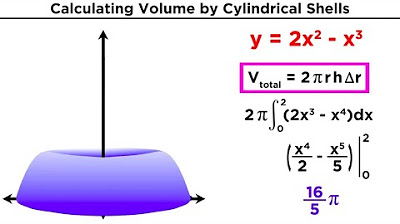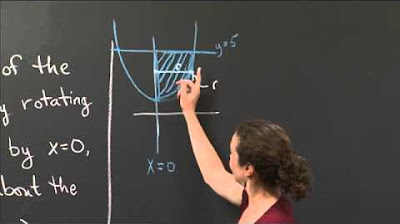Solid of Revolution (part 6)
TLDRIn this video, the presenter explores an alternative method for calculating the volume of a solid of revolution, specifically using the disk method instead of the shell method. The focus is on visualizing the problem by rotating a curve around the y-axis and switching the roles of x and y. The presenter demonstrates how to set up the integral for the volume of a disk, taking into account the radius and width in terms of y, and then subtracting the volume of an inner 'bowl'. Despite the initial confusion with variable switching, the final result confirms the validity of the approach, showing that the disk method yields the same answer as the shell method, reinforcing the importance of visualization and understanding of calculus concepts.
Takeaways
- 📈 The problem discussed involves finding the volume of a solid generated by rotating a curve around an axis.
- 🔄 In the previous video, the Shell method was used to find the volume, yielding an answer of π/2.
- 🔧 This video introduces an alternative approach, the Disk method, which can be applied by switching the roles of x and y in the function.
- 🌀 The curve y = x^2 is considered, and its inverse function x = √y is used to apply the Disk method.
- 📐 The volume of a disk is calculated as the radius squared times π times the differential in y (dy).
- 🚫 A common mistake when switching variables is to confuse the anti-derivatives and derivatives of the functions involved.
- 🧩 The volume of the entire cylinder is considered first, from y=0 to y=1, using the function x=1.
- 🔄 The inner volume (the bowl shape) is subtracted from the entire cylinder to find the volume of the solid.
- 📐 The anti-derivative of 1 with respect to y is simply y, which was a point of confusion in the explanation.
- 📊 The final result, after accounting for the inner and outer volumes, confirms the previous answer of π/2, validating the method.
- 🎥 The video script serves as a tutorial on problem-solving in calculus, emphasizing the importance of visualization and understanding of concepts.
Q & A
What was the integral curve discussed in the video?
-The integral curve discussed in the video was y equals x square.
What method was initially used to calculate the volume in the example provided?
-The Shell method was initially used to calculate the volume, resulting in an answer of pi over 2.
How was the function of the curve rewritten to apply the Disk method?
-The function was rewritten as x equals the square root of y to apply the Disk method.
What is the volume calculation formula for a disk?
-The volume of a disk is calculated as the radius squared times pi times dy.
How was the volume of the entire cylinder calculated?
-The volume of the entire cylinder was calculated by integrating from y equals 1 to y equals 0.
What was the role of the inner and outer functions in the volume calculation?
-The inner and outer functions were used to calculate the volume of the 'bowl' shape by subtracting the volume of the inner bowl from the volume of the entire cylinder.
What was the anti-derivative of 1 with respect to y?
-The anti-derivative of 1 with respect to y is y.
What was the final result of the volume calculation using the Disk method?
-The final result of the volume calculation using the Disk method was pi over 2, which matched the result obtained using the Shell method.
How did the讲师 handle the switch from x to y in the calculations?
-The讲师 handled the switch by rewriting the function in terms of y and adjusting the integrals accordingly, emphasizing the importance of visualizing the problem and understanding the calculus involved.
What was the讲师's comment on the difficulty of the problem?
-The 讲师 mentioned that the hardest part was visualizing the problem and that the Disk method involved horizontal disks instead of the traditional vertical disks, which might be confusing.
What was the讲师's approach to dealing with the anti-derivatives during the calculation?
-The 讲师 took the anti-derivatives by considering the function with respect to y and finding the appropriate anti-derivatives based on the derivatives involved.
Outlines
📚 Introduction to the Disk Method and Volume Calculation
This paragraph introduces the concept of using the disk method to calculate the volume of a solid of revolution. It begins by reviewing the previous video's use of the shell method for a function of x, and then transitions into explaining how to apply the disk method by switching the roles of x and y. The speaker clarifies that instead of considering the length of y=x^2 from 0 to 1 on the x-axis, we will now look at it as a function of y and take the inverse, x=√y. The visualization of the problem is emphasized as crucial for understanding the calculus involved. The paragraph also discusses the concept of cross sections and how the rotation around the y-axis gives us the figure in question. The speaker then explains how to deal with disks in this new context, highlighting the change in perspective from traditional vertical disks to horizontal ones by considering the radius as x and the width as a differential y (dy). The volume of a single disk is described as the radius squared (x^2) times pi times dy, and the process of setting up the integral for the entire cylinder is outlined, with the volume calculated from y=1 to y=0.
🔄 Subtracting the Inner Bowl Volume and Final Calculation
The second paragraph delves into the process of subtracting the volume of the inner bowl from the larger cylinder to find the final volume. The speaker explains that this involves using the function x=√y for the inner function and maintaining the boundaries of y from 0 to 1. The concept of dealing with horizontal disks is reiterated, and the speaker clarifies that the volume calculations remain the same, only the orientation changes. The paragraph details the steps of setting up the integral for the inner bowl, taking the volume of the cylinder with x=1, and then subtracting the inner volume, which involves the function f(y)=√y. The integral is set up as π times (1^2 dy - √y^2 dy) from y=0 to y=1. The speaker works through the anti-derivatives and the evaluation of the integral, ultimately obtaining the same result as in the previous video, which serves as a validation of the method. The paragraph concludes with an acknowledgment of the complexity involved in switching x and y and reassures that despite potential confusion, the method is sound and effective.
Mindmap
Keywords
💡Shell method
💡Disk method
💡Volume
💡Rotational symmetry
💡Integration
💡Differential
💡Visualization
💡Curve
💡Solid of revolution
💡Anti-derivative
💡Calculus
Highlights
The video discusses the calculation of the volume of a solid of revolution by rotating a curve around an axis.
Previously, the length of y was considered, but this time the focus is on the area under the curve from x=0 to x=1.
The method used in the video is the Shell method, which was applied to find the volume as pi over 2.
The video introduces an alternative approach, the Disk method, which is typically used for rotation around the x-axis but is adapted for the y-axis in this case.
To use the Disk method, the function y=x^2 is inverted to x=sqrt(y), switching the roles of x and y in the calculations.
The visualization of the problem is emphasized as a key aspect of understanding the calculus involved.
The cross section of the solid is described to help visualize the Disk method application.
The volume of a single disk is calculated as the radius squared times pi times dy.
The problem involves calculating the volume of the entire cylinder and then subtracting the volume of the inner bowl.
The inner bowl's volume is calculated using the function f(y) = sqrt(y), with y ranging from 0 to 1.
The anti-derivative of 1 with respect to y is found to be y, which is used in the volume calculation.
The final result of the volume calculation using the Disk method matches the previous result using the Shell method, which is pi/2.
The video emphasizes the importance of correctly handling variable switches and understanding the boundaries of the integrals.
The concept of horizontal disks is introduced, as opposed to the traditional vertical disks, for the y-axis rotation.
The video concludes with a reminder of the upcoming content, which will involve more complex problems.
Transcripts
Browse More Related Video

Solid of Revolution (part 5)

2011 Calculus AB free response #3 (c) | AP Calculus AB | Khan Academy

Solid of revolution between two functions (leading up to the washer method) | Khan Academy

AP Calculus AB: Lesson 7.5: Shell Method

Calculating Volume by Cylindrical Shells

Volume of a Paraboloid via Disks | MIT 18.01SC Single Variable Calculus, Fall 2010
5.0 / 5 (0 votes)
Thanks for rating: